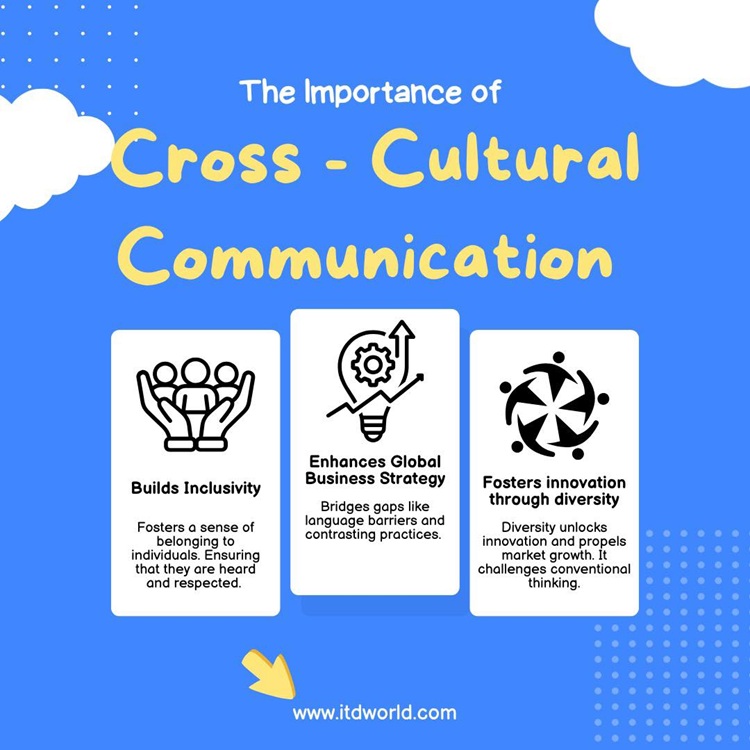This practical guide equips leaders and coaches with the skills to navigate cross-cultural communication, fostering collaboration and driving results in a globalized world.
As the world becomes more globalized, the ability to communicate effectively across cultures has become crucial for leaders and coaches tasked with driving teams and clients for results. Those who can make their points across the divide lay the foundation for successful outcomes. By cultivating robust cross-cultural communication skills, one becomes better equipped to establish rich interpersonal interactions that foster a conducive work environment.
|
Author: Aaron Ngui |
Highlights
- Cross-cultural communication studies how people from various backgrounds interact through verbal and nonverbal cues, with the aim of bridging cultural gaps for better understanding. Effective communication helps build inclusive workplaces, drive global business success, and foster innovation through diverse perspectives.
- In the realm of coaching, cross-cultural communication requires adapting one’s methods to the client’s background for a more effective and trusting experience.
- Intercultural communication involves understanding both verbal (language) and nonverbal cues (body language, silence, etc.) to navigate interactions with people from different backgrounds.
- Active listening, cultural awareness, and adaptability are key to fostering trust and ensuring the success of cross-cultural leadership and coaching.
What is Cross-Cultural Communication?
Cross-cultural communication (also referred to as intercultural communication) is the study of how people from different backgrounds (nationality, ethnicity, religion, and even social groups) interact with each other through communication. This includes both verbal and nonverbal interaction – i.e. the words that are said and the way they are said, along with gestures, body language, and even things like personal space.
Essentially, intercultural communication explores how cultural differences may lead to misinterpretations. For instance, a simple thumbs-up gesture might be a friendly sign in some cultures, but offensive in others. Likewise, direct communication might be seen as rude in some cultures, while indirectness might be perceived as unclear/ shirking responsibilities. By recognizing these nuances and adapting your approach to bridge the gap, one may be better equipped to establish harmony and stronger relationships with people from other backgrounds.
Examples:
- Business meeting between colleagues from different countries: Understanding how much direct eye contact is considered respectful, or the appropriate way to greet each other (bowing in some cultures, handshake in others).
- Traveling to a new country: Being aware of local customs like appropriate clothing or tipping etiquette.
- Social media interaction with people from different backgrounds: Using emojis that might be perceived differently across cultures, or avoiding humor that might not translate well.

What best defines intercultural communication
The Importance of Cross-Cultural Communication in the Workplace
Cross-cultural communication is essential to build an inclusive workplace. This is where diverse ideas are respected and utilized. Leaders equipped with such skills are better positioned to manage a global workforce to drive productivity and innovation.
-
Building inclusivity
When cross-cultural communication thrives, it cultivates an inclusive environment – which fosters a sense of belonging for employees of all backgrounds, ensuring their voices are valued and respected. As suggested by Harvard Business Review, embracing diversity‘s value, tackling bias through training, and practicing inclusive leadership are all crucial for building such a workplace.
Consider the case of Maria, who leads the marketing function of a multinational corporation. When she took over her international team, she noticed significant disconnects in team interactions. By engaging in cultural competence training and applying these insights to her communication style, Maria transformed her team’s dynamics.
Leaders like Maria exemplify the transformation that occurs when inclusive practices are integrated. By valuing the diverse cultural expressions of her team members, she boosted morale and created a collaborative environment where all felt valued. This inclusivity extends beyond meetings; it influences project management, conflict resolution, and strategic decision-making, making the workplace a model for collaboration.
-
Enhancing global business strategy
Intercultural communication acts as the key to unlocking successful global business strategies. By navigating cultural intricacies, businesses foster strong international collaborations, which lay the foundation for strengthening business relations and facilitating deals. At the same time, it also bridges gaps like language barriers and contrasting business practices.
Imagine the situation of Akio, a CEO from Japan who expanded his business to Brazil. In the beginning, his reserved style of communication did not resonate with the Brazilian team. They valued a more open and expressive style instead.
Recognizing he was not getting his points across, Akio took cross-cultural communication classes and adapted his style to the local conditions. He embraced more open dialogues and became more active in informal interaction. Doing so helped bridge the gap between professional culture which helped to boost the market penetration.
His case is not a unique one. When done properly, cross-cultural communication creates a strategic advantage for organizations. Leaders who adapt their approach to align with the cultural context enhance their influence and leadership. A tailored approach allows teams to tailor marketing strategies, product development, and customer service approaches that fit a diverse customer base.
-
Fostering innovation through diverse perspectives
A tapestry of perspectives fuels innovation. When employees from diverse backgrounds collaborate, their unique viewpoints spark creative problem-solving and lead to groundbreaking solutions. This isn’t just anecdotal – in fact, a study by Forbes has confirmed that diversity challenges conventional thinking, thereby fostering fresh ideas. Similarly, Harvard Business Review’s research also emphasizes how diversity unlocks innovation and propels market growth.
For instance, a tech company in Kuala Lumpur leveraged its culturally diverse team to innovate a food ordering app that outperformed existing ones, primarily because the team’s diverse inputs led to a more intuitive and accurate product.

I do not wish my house to be walled on all sides and my windows stuffed. I want the cultures of all lands to be blown about my house as freely as possible.
Mahatma Gandhi, Independence Activist
Cross-cultural communication examples in real-life
Cross-Cultural Communication in Coaching
Effective coaching in today’s multicultural landscape requires adaptability to various cultural norms and communication styles. This skill enhances the coach-coachee relationship, ensuring that coaching methods are appropriately aligned with the client’s background.
-
Coaching across borders
Cross-cultural competence is vital in coaching. An example is Sarah, a life coach based in the United Kingdom (UK). She works predominantly with clients from the Middle East. She initially struggled to connect with others due to her direct approach. This contrasted with their preference for a more circumspect communication style. By catering to these cultural nuances, Sarah was able to build stronger rapport and support them towards their goals.
This example underscores the need for cultural sensitivity in coaching. Those who navigate these cultural nuances foster a deeper sense of trust and respect. Coaches who can adapt their style to better align with the coachees’ cultural expectations improve their effectiveness. This boosts client satisfaction and may also positively impact retention.
-
Culturally adaptive coaching
Understanding and integrating multiple cultural perspectives may lead to increased coaching effectiveness. For example, incorporating Eastern wisdom or philosophical approaches like emphasizing collective success may resonate more with coachees from an Asian background. Conversely, the coach can adjust the conversation to fit the mentality of coachees from a more individualized culture. By adapting their approach, people become more receptive and engaged – thereby maximizing the opportunities for success and satisfaction.
When coaches stay focused and flexible by incorporating various cultural elements during their conversations, they cater to a broader audience. This enriches the personal development of the journey for the people they coach as they open their minds to new understandings.
-
Leveraging cultural competence for team coaching
Team coaching that accounts for cultural differences may lead to more cohesive and productive teams. For example, a coach working with multinational corporations may design leadership retreats that focus on cultural exchange and team-building activities tailored to various cultural practices, which unites workplace efforts and significantly improves team dynamics and performance.
Activities for such retreats to build cross-cultural competence could include problem-solving workshops, in which participants are mixed culturally and given complex problems to solve. These challenges may be based on real-world situations the organization faces. By mixing them together, team members are given the opportunity to tap into their diversity and find strength in the differences to identify innovative solutions.
Read more: Coaching Culture – Blueprint for Organizational Growth
Types of Cross-Cultural Communication
Generally speaking, intercultural communication can be broadly broken down into two main types:
-
Verbal communication
This refers to the exchange of information through spoken or written language, including:
- Formal vs informal language: Many cultures have different levels of formality in speech depending on the situation and who you are speaking to. For instance, in some countries (e.g. Japan), it might be considered disrespectful to use informal language with someone older/ in a position of authority/ customers and clients. As a result, an American businessperson giving a presentation to a Japanese audience might want to avoid using idioms or humor too much.
- Direct vs indirect communication: In some cultures, people are more direct in their communication style (e.g. they might not be hesitant to say “no” directly if they disagree with something), while others are more indirect (e.g. they might respond with “maybe” or “I’ll have to think about it” even if what they truly mean is “no”). If you are not aware of such a difference, misunderstandings are inevitable.
-
Nonverbal communication
This refers to all forms of communication that do not involve words, such as body language, facial expressions, gestures, and even silence:
- Body language: In some cultures, making eye contact is a sign of respect, while in others, it is considered rude. Similarly, the use of gestures may also vary. As mentioned, a thumbs-up might be a positive sign in one culture and an insult in another.
- Facial expressions: For example, a smile might be a sign of happiness in one culture, but it could also indicate nervousness or embarrassment in another.
- Personal space: In some cultures, people stand very close together when they talk, while in others, they may prefer to have more space.
- Silence: In some countries, silence is seen as a sign of respect, while in others, it may be deemed as awkward or impolite.
Understanding both types above is essential for effective cross-cultural communication. Additionally, some other factors to consider include:
- Context: For example, what is considered appropriate humor in a casual conversation might be offensive in a formal setting.
- Cultural values: Some cultures are more individualistic, while others are more collectivistic. This can affect how people approach decision-making and communication.
- Social status: Those from countries with high power distance may prefer more indirect communication than others.

Challenges of intercultural communication
Cross-Cultural Communication Skills
- Cultural awareness
As the foundation of good cross-cultural communication, it involves demonstrating a basic understanding of different cultures, their values, beliefs, customs, and communication styles. Such awareness may be acquired by reading books and articles, watching documentaries, or even taking classes on intercultural communication.
- Open-mindedness and respect
Being open to new ideas, respecting differences, and refraining from judging/ stereotyping people based on their cultural background.
Pay close attention to what the other person is saying, both verbally and nonverbally, so as to gain a better grasp of their perspectives.
- Clear and concise communication
Avoid slang, jargon, or idioms that might not be understood by someone from another culture. In addition, use humor carefully, as it may not translate well across cultures.
- Adaptability
Be flexible and willing to change your communication style based on the situation and the person you are interacting with.
- Patience
Building relationships and understanding across cultures takes time. As such, one needs to be patient and avoid getting frustrated if misunderstandings occur.
- Nonverbal communication awareness
Be mindful of one’s body language, facial expressions, and gestures, as they can have different meanings in different cultures.
- Minimize assumptions
Don’t assume that people from other cultures interpret things the same way you do. Instead, always seek to clarify and confirm understanding.
- Foreign language skills
While not always necessary, having some basic knowledge of the other person’s language can go a long way in building rapport and fostering better relationships. In case of language barriers, visuals like charts, graphs, or pictures may be leveraged to support your communication.
- Be open to feedback
If someone points out that you’ve done something that is considered rude or disrespectful in their culture, be receptive to the feedback and apologize if necessary.
Briefly summarize the key points of your conversation to ensure everyone is on the same page. If necessary, consider following up with a confirmation email or phone call to reiterate any important points or next steps.

Intercultural communication techniques
Strategies for Enhancing Cross-Cultural Communication in the Workplace
To effectively communicate across cultures, leaders and coaches need to employ specific strategies that go beyond basic language skills, focusing on deeper cultural understanding and interpersonal engagement.
-
Active listening & empathy
Active listening and demonstrating empathy are crucial in cross-cultural settings. Those who prioritize understanding the emotional and contextual nuances of their team members or clients are more capable of making informed decisions that respect cultural sensitivities.
-
Language & non-verbal cues
The importance of non-verbal communication cues may differ significantly across cultures. Being aware of and understanding these differences is crucial for avoiding miscommunications and building respectful relationships. This includes studying body language, personal space, and even the appropriate use of silence, which can vary widely between cultures.
-
Invest in building trust
Consider going beyond active listening and delving into specific techniques for building trust across cultures. This could include using inclusive language, acknowledging cultural holidays and traditions, and providing opportunities for team members to share their cultural backgrounds (e.g. cultural events, potlucks, or language exchange programs). On top of that, organizations should invest in workshops or training programs that teach employees about different cultures/ communication styles – as well as establish mentorship programs where experienced employees are tasked with guiding and supporting newcomers from different cultural backgrounds.
-
Make use of technology
Given the latest technological advancements, technology should be utilized to better facilitate cross-cultural communication in the workplace. Translation tools, video conferencing platforms, and project management software can all be leveraged to help bridge geographical and cultural divides.
-
Continuous learning & adaptation
The most successful cross-cultural communicators are those who view cultural competence as a journey rather than a destination. This involves ongoing learning about other cultures, self-reflection on one’s own cultural biases, and the flexibility to adapt practices as needed. Although this may be challenging, successful leaders and coaches are those who thrive on challenges and flexibility. Attending and implementing what one learns from training sessions, workshops, and real-world experiences puts one in a good position to develop these competencies.
Cross-cultural communication is a dynamic and essential skill for leaders and coaches working in diverse environments. By embracing cultural differences and adapting communication styles, one may foster more effective, inclusive, and successful interactions – which allow them to lead and inspire far more effectively than those who remain within their cultural comfort zones.

Cross-cultural communication principles
To effectively communicate, we must realize that we are all different in the way we perceive the world and use this understanding as a guide to our communication with others from different cultures.
Tony Robbins, Motivational Speaker
Cross-Cultural Communication Training is Vital for Leaders and Coaches
Leaders and coaches are encouraged to continuously develop their cross-cultural communication skills through training, practice, and openness to diverse perspectives. In doing so, they enhance their own capabilities and contribute to more harmonious and productive workplaces worldwide.
Other resources you might be interested in:
- Human Leadership in a Digital World: Skills & Strategies for Sustainable Success
- Can Introverts be Effective Leaders?
- Situational Leadership: Guide to Implementation
- Leadership Effectiveness: From Intent to Impact
- Leadership Development: A Mission-critical Strategic Function

